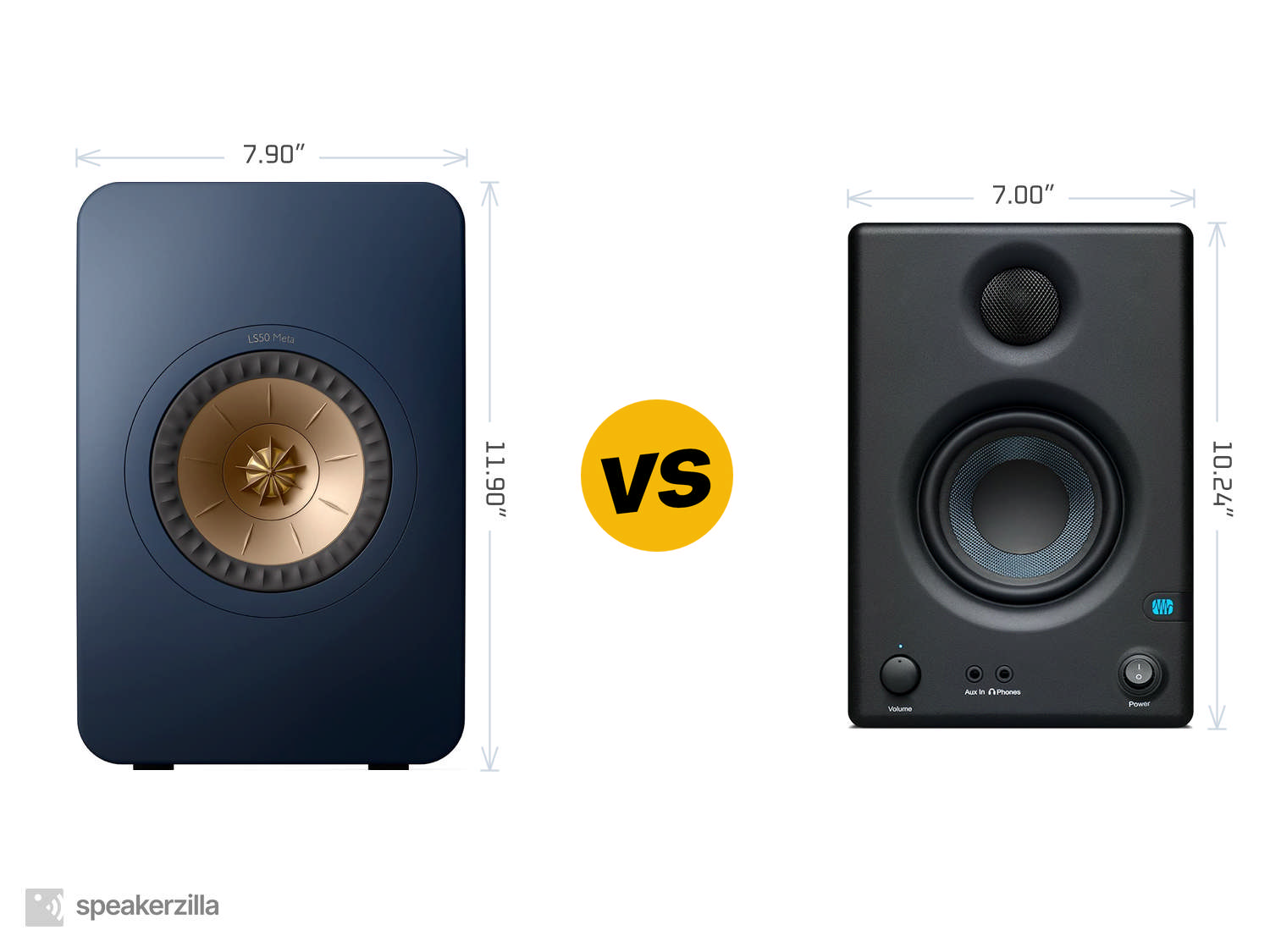KEF LS50 Meta vs. Presonus Eris E3.5

| KEF LS50 Meta Bookshelf Speakers | Presonus Eris E3.5 3.5” Near Field Studio Monitor |
| MSRP | |
| $1600 | $100 |
| Dimensions (H × W × D) | |
|
11.90” × 7.90” × 11.00” 302mm × 201mm × 279mm |
10.24” × 7.00” × 7.68” 260mm × 178mm × 195mm |
| Power Type | |
| Passive | Powered |
| Frequency Response | |
| 79-28,000 Hz | 80-20,000 Hz |
| ASR Score | |
| 4.6 | 1.5 |
| ASR Score w/Subwoofer | |
| 6.7 | 4.3 |
|
Amazon.com
|
Amazon.com
|
Key Takeaways
TLDR Summary: In the realm of high-fidelity sound, the KEF LS50 Meta speakers and PreSonus Eris E3.5 monitors serve distinct audiences. The LS50 Meta, with its patented Uni-Q driver and Metamaterial Absorption Technology, offers refined, room-filling audio that captivates audiophiles seeking sonic purity and detailed soundstaging. In contrast, the Eris E3.5 caters to creators and home studios, focusing on accurate sound reproduction for mixing and everyday multimedia use. While the LS50 Metas are a premium investment in audiophile listening, the Eris E3.5 provides an affordable, compact solution for those who prize clarity and balance for professional applications.
Speaker Comparison
When discussing the realms of high-fidelity audio and studio monitoring, the conversation often orbits around two key considerations: sound quality and application. The KEF LS50 Meta bookshelf speakers and the Presonus Eris E3.5 near-field studio monitors are two contenders that, while differing in positioning and audience, invite a fascinating comparison for those intrigued by the nuances of their auditory signatures and design philosophies.
Design and Build Quality
KEF's LS50 Meta speakers epitomize the brand's sterling reputation for high-end design and acoustic innovation. The notable Uni-Q driver array marries the tweeter and midrange driver, resulting in a seamless integration of frequencies and a wide soundstage. The LS50 Meta's enclosure, engineered with a complex constrained layer damping bracing technique, eliminates much of the cabinet resonance, allowing for a purer sound. In contrast, the Presonus Eris E3.5 speakers offer a more utilitarian design aimed at budget-conscious consumers and fledgling audio engineers. The build quality is respectable for its price range, but it lacks the sophisticated materials and design flourishes that KEF brings to the table.

 (at Amazon.com)
(at Amazon.com)Performance and Sound Quality
The KEF LS50 Meta speakers are a paragon of clarity and detail. Their refined sound signature is characterized by an impressive balance across frequencies, with tight bass, rich mids, and crisp highs. The LS50 Metas are also known for their incredible imaging capabilities, creating a holographic soundscape that can locate each instrument within a three-dimensional space. Conversely, the Presonus Eris E3.5 monitors, while commendable for their size and cost, are more utilitarian. They handle midrange frequencies well and have a decent transient response, but the smaller drivers naturally limit the bass response and overall dynamism when compared to the KEFs.
Application and Versatility
It's important to recognize that the intended use for these speakers is inherently different. The LS50 Meta is designed with the discerning audiophile in mind. These speakers shine in a dedicated listening room where the focus is on enjoying music in its most pristine form. Conversely, Presonus' Eris E3.5 monitors are crafted for content creators, amateur mixers, and those requiring accurate sound reproduction for multimedia production. Their near-field design is optimized for a clear and flat response at close range, which is ideal for small home studios.

 (at Amazon.com)
(at Amazon.com)Connectivity is another area where the LS50 Meta and Eris E3.5 diverge. KEF has designed the LS50 Meta as a passive speaker, necessitating a separate amplifier to drive them. This could be seen as a boon or a barrier, depending on one's existing setup and willingness to invest in additional audio equipment. The Eris E3.5, on the other hand, is an active speaker with onboard amplification, making it a more plug-and-play solution, particularly appealing to those with space constraints or the need for a more portable setup.
Compare to similar speakers
Price is, of course, a significant factor in any comparison. The LS50 Meta is a premium offering that demands a commensurate price point, reflecting its high-end components, design, and performance. The Eris E3.5 sits at a much more accessible price bracket, offering a compelling option for those who are budget-conscious but still seek quality audio reproduction for their creative endeavors or casual listening.
In conclusion, the KEF LS50 Meta and Presonus Eris E3.5 serve different masters but are both leaders within their respective niches. The LS50 Meta is a testament to KEF's pursuit of acoustic excellence, delivering an audiophile experience that envelops the listener in a meticulously crafted sound field. The Eris E3.5, while modest in comparison, provides a clear and honest sound that is indispensable for audio production and mixing within close quarters. Both models affirm that whether your priority is the impassioned enjoyment of music or the precision required in production, there is a speaker designed to meet those distinct needs.
- KEF LS50 Meta reviews and FAQs
- Presonus Eris E3.5 reviews and FAQs
Check Current Prices: |
|
|
Amazon.com
|
Amazon.com
|
Affiliate Disclosure: As an Amazon Associate, we earn from qualifying purchases.

